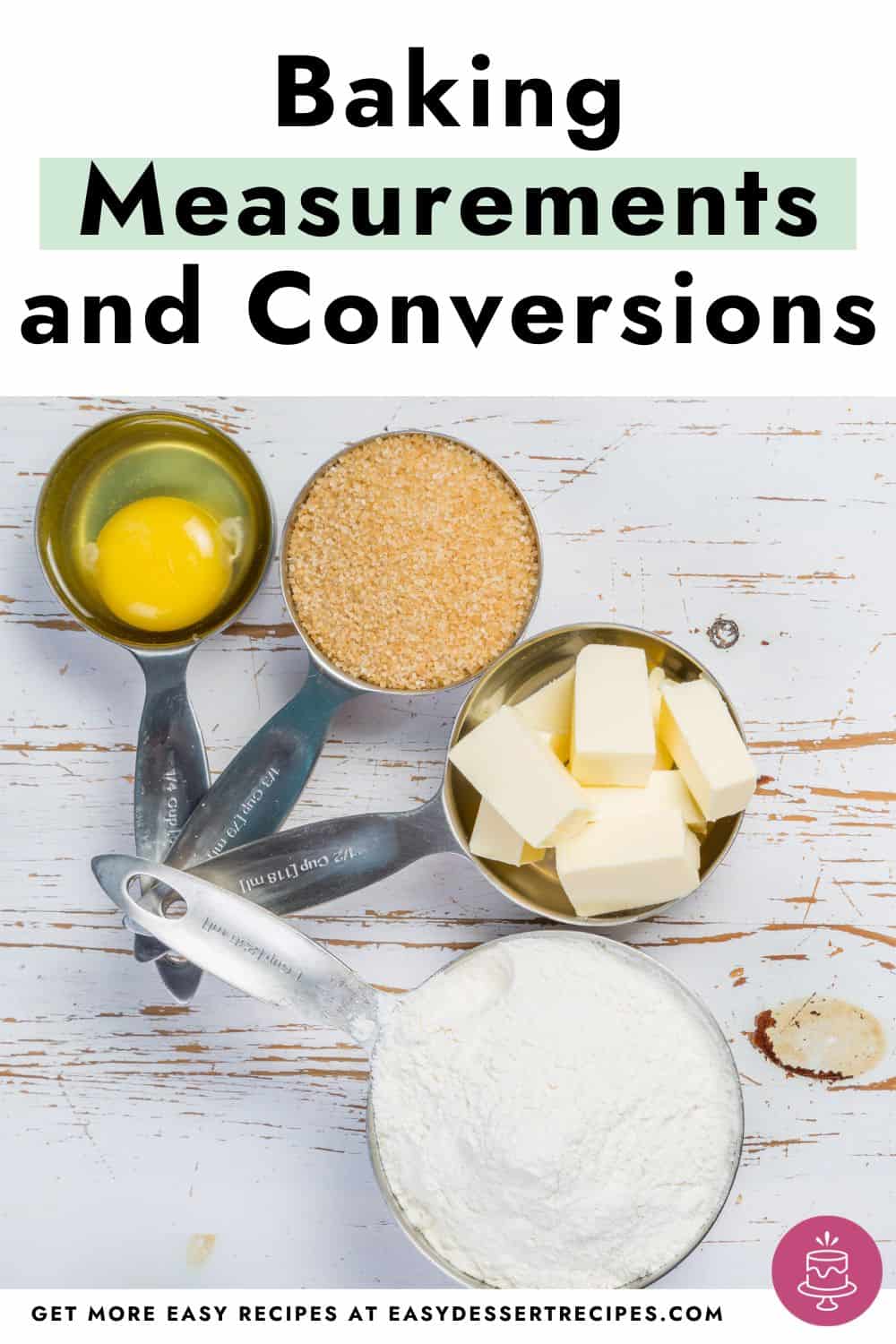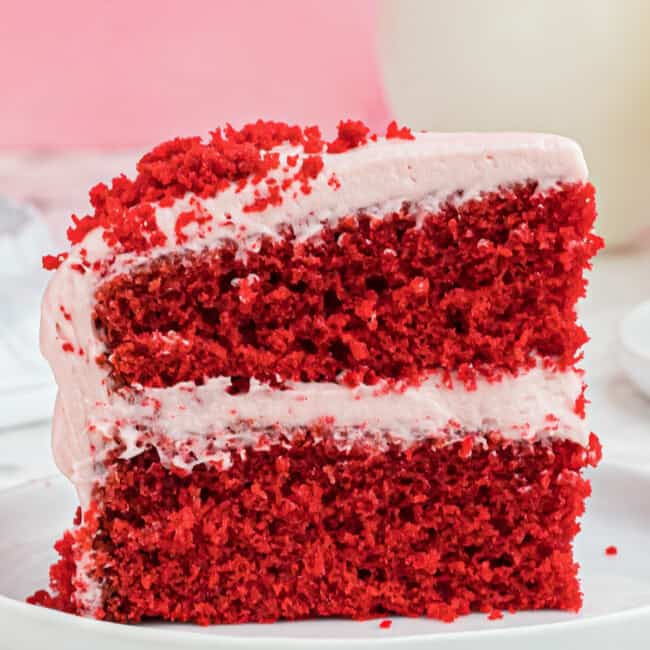Baking measurements are an important part of any baking recipe, but sometimes getting things right requires a bit of math. I’ve done the hard part for you, and put together lots of kitchen measurement conversion charts, so you can find equivalents with ease. Convert metric to standard (and back), teaspoons to tablespoons, or any kind of cooking measurement you might need!

Baking and Cooking Measurements
When it comes to baking recipes, correct ingredient measurements are a very important element. Whether you’re following a recipe that uses standard/imperial measurements, or metric measurements, you’ll need to follow them to a T.
Part of that process means understanding basic baking measurements (teaspoons, tablespoons, cups, ounces, etc.), and being able to easily convert those measurements as needed (to grams, milliliters etc.). So I’m here to give you all of the information you need to know to make measuring EASY (with as little math as possible).
I’m sharing all the measurement conversion charts you could need, so you don’t have to figure any of that out on the go. Plus I’m talking about measurement abbreviations, equivalents, converting metric to standard (and vice versa), and the measurements for common baking ingredients.
I’m also going to briefly talk about measuring liquid ingredients vs dry ingredients, ounces vs. fluid ounces, and weighing ingredients.


Email This Recipe
Enter your email and we’ll send the recipe directly to you!
Kitchen Measuring Tools
Let’s start with the tools you’ll need in your kitchen to measure ingredients. A basic set of spoons and cups will suffice for most home baking. Using a kitchen scale is recommended for the most accurate measurements (measuring by weight).
- Measuring spoons
- Measuring cups
- Liquid measuring cups
- Kitchen scale
Cooking Measurement Abbreviations
Next up, we need to talk about kitchen measurement abbreviations. Most recipes will use these abbreviations, instead of spelling them out for every single ingredient. So here’s a quick reference chart for both standard and metric measurements.
- Tbsp = tablespoon
- Tsp = teaspoon
- Oz = ounce
- Fl. oz = fluid ounce
- C = cup
- Qt = quart
- Pt = pint
- Gal = gallon
- Lb – pound
- Ml = milliliter
- L = liter
- G = gram
- Kg = kilogram
Baking Conversions and Equivalents
Understanding basic cooking measurements and their equivalents is so helpful when it comes to baking and making desserts. Whether you’re measuring liquid or dry ingredients, you’ll want to know how those measurements relate to each other.
You might be missing the ¼ cup from your set, or maybe you’re trying to double or halve a recipe. Whatever the reason, sometimes you just need to know how many teaspoons are in a tablespoon, or how many tablespoons are in a cup.
So below you can find all the charts you need to move from one measurement to another!
Dry Measurements Conversion Chart
| Teaspoons | Tablespoons | Cups |
|---|---|---|
| 3 tsp | 1 tbsp | 1/16 c |
| 6 tsp | 2 tbsp | 1/8 c |
| 12 tsp | 4 tbsp | 1/4 c |
| 24 tsp | 8 tbsp | 1/2 c |
| 36 tsp | 12 tbsp | 3/4 c |
| 48 tsp | 16 tbsp | 1 c |
Liquid Measurements Conversion Chart
| Fluid Ounces | Cups | Pints | Quarts | Gallons |
|---|---|---|---|---|
| 8 fl oz | 1 c | 1/2 pt | 1/4 qt | 1/16 gal |
| 16 fl oz | 2 c | 1 pt | 1/2 qt | 1/8 gal |
| 32 fl oz | 4 c | 2 pt | 1 qt | 1/4 gal |
| 64 fl oz | 8 c | 4 pt | 2 qt | 1/2 gal |
| 128 fl oz | 16 c | 8 pt | 4 qt | 1 gal |
Butter Measurements Chart
| Sticks | Cups | Tablespoons | Ounces | Grams |
|---|---|---|---|---|
| 1/2 stick | 1/4 c | 4 tbsp | 2 oz | 57 g |
| 1 stick | 1/2 c | 8 tbsp | 4 oz | 113 g |
| 2 sticks | 1 c | 16 tbsp | 8 oz | 226 g |
Metric Cooking Measurements vs Standard Cooking Measurements
Most of the world uses the metric system for all measurements, including in the kitchen. But here in the U.S. we generally use the Standard (or Imperial) system. So that means there is a difference in the types of measurement units we use when baking or cooking.
- Standard Cooking Measurements: teaspoons, tablespoons, cups, ounces and fluid ounces, pints, quarts, gallons, pounds.
- Metric Cooking Measurements: grams, kilograms, milliliters, liters.
Clearly the standard system is a little bit more confusing to begin with (which is why I have this whole measurements guide for you).
Metric to Standard Baking Conversions
So what happens when you want to follow a recipe that uses metric cooking measurements, but you only know (and only have tools for) standard cooking measurements? Well that’s where cooking conversion charts come in handy!
Whether you’re trying to measure volume or weight, or need to convert oven temperatures from Celsius to Fahrenheit (or vice versa), these charts will help you get it right.
Oven Temperatures Conversion
| (Degrees) Celsius | (Degrees) Fahrenheit |
|---|---|
| 120°C | 250°F |
| 160°C | 320°F |
| 180°C | 350°F |
| 205°C | 400°F |
| 220°C | 425°F |
Liquid Measurements (Volume)
| Metric | Standard |
|---|---|
| 1 ml | 1/5 tsp |
| 5 ml | 1 tsp |
| 15 ml | 1 tbsp |
| 240 ml | 1 c (8 fl oz) |
| 1 l | 34 fl oz |
Dry Measurements (Weight)
| Metric | Standard |
|---|---|
| 1 g | .035 oz |
| 100 g | 3.5 oz |
| 500 g | 17.7 oz (1.1 lb) |
| 1 kg | 35 oz |
Standard to Metric Baking Conversions
| Standard | Metric |
|---|---|
| 1/5 tsp | 1 ml |
| 1 tsp | 5 ml |
| 1 tbsp | 15 ml |
| 1 fl oz | 30 ml |
| 1 c | 237 ml |
| 1 pt | 473 ml |
| 1 qt | .95 l |
| 1 gal | 3.8 l |
| 1 oz | 28 g |
| 1 lb | 454 g |
Common Baking Measurements and Conversions
Measuring ingredients in weight vs. volume will give you different results, so pay attention to how the recipe is measuring everything. To help convert measurements and find the equivalents, it helps to know what common baking ingredients weigh based on their volume measurement. This will allow you to weigh everything for more accuracy if you prefer. I’m sharing charts for both ounces (standard) and grams (metric).
Baking Ingredients in Ounces
| Ingredient | Ounces |
|---|---|
| 1 c. all-purpose flour | 4.5 oz |
| 1 c. granulated sugar | 7.1 oz |
| 1 c. unsifted powdered sugar | 4.4 oz |
| 1 c. packed brown sugar | 7.75 oz |
| 1 c. rolled oats | 3 oz |
| 1 c. vegetable oil | 7.7 oz |
| 1 c. milk | 8 oz |
| 1 c. heavy cream | 8.4 oz |
| 1 c. butter | 8 oz |
| 1 large egg | 1.7 oz |
Baking Ingredients in Grams
| Ingredient | Grams |
|---|---|
| 1 c. all-purpose flour | 120 g |
| 1 c. granulated sugar | 200 g |
| 1 c. unsifted powdered sugar | 113 g |
| 1 c. packed brown sugar | 213 g |
| 1 c. rolled oats | 85 g |
| 1 c. vegetable oil | 200 g |
| 1 c. milk | 227 g |
| 1 c. heavy cream | 227 g |
| 1 c. butter | 226 g |
| 1 large egg | 50 g |
Measuring Liquid Ingredients vs Dry Ingredients
This is a pretty straightforward difference, but let me explain anyway. Liquid ingredients are anything that is liquid-based (like milk, creams, and water). Dry ingredients are anything that is not liquid (flour, sugars, baking powder, etc.). And there is a difference in how you measure each, even though both will typically be listed in the same measurement units (in the standard system).
Liquid ingredients should be measured in liquid measuring cups. Dry ingredients should be measured in dry measuring cups and spoons. This does affect the accuracy of the measurement, so stick to it as much as possible when baking.
Ounces vs Fluid Ounces
Ounces are a measurement of weight, while fluid ounces are a measurement of volume. This is an important difference, because trying to measure one by the other will give you very different results. As you can see in the charts above, not all ingredients have the same weight, despite occupying the same amount of space (volume).
Luckily, only dry ingredients will be measured in ounces, while liquid ingredients will be measured in fluid ounces.
Weighing Ingredients
When it comes to perfect baking, it’s recommended that you weigh your ingredients (ounces or grams) instead of using volume measurements (cups, teaspoons, etc.). This will give you the most accurate results, and you’ll have the convenience of using your scale for everything, instead of using a mix of cups and spoons.
However, if you’re more of a casual home baker, you probably don’t have a kitchen scale. So many baking recipes use volume measurements for convenience.

I hope these measurement conversions, charts, and equivalents are helpful to you in your home baking and cooking!
Why not start with some of our favorites? They’re all easy recipes to follow, something you’re sure to love!


























Leave a Review